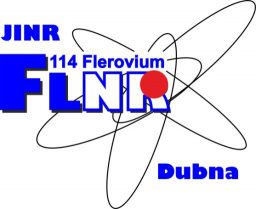Nonstationary description of low-energy reactions: transfers, breakup, manifestation of the structure of light nuclei/Experimental study of the mechanisms of interaction between heavy nuclei
28.02.2023 – FLNR Scientific Seminar, 15-30, FlerovLab Conference Hall
1. Speaker: Samarin V.V., FLNR, JINR
(in connection with the election for the position of leading research scientist)
“Nonstationary description of low-energy reactions: transfers, breakup, manifestation of the structure of light nuclei.”
The basics and results of application of the non-stationary approach to the description of the low-energy reactions are presented here. Alpha-cluster transfers and fast alpha-particle escape during complete or incomplete fusion of nuclei are considered. For nucleon transfer channels and breakup channel for weakly coupled nuclei the approach includes spin-orbit interactions and colliding nuclei deformations. Transfers are considered for the strongly bound nucleons of heavy ions (40Ca, 124Sn, 18O, 181Ta, 197Au) and light nuclei (3Не, 10Be). In calculations for 6,8He+197Au reactions nucleon-nucleon correlations are taken into account by introducing the phenomenological imaginary part of the neutron-nucleus potential. For weakly bound nucleons of 8,11Li, 11Be, 8B nuclei the transfer and breakup cross sections are calculated. The structures of 9,10,11,12Be, 10,11,14B, 10,11,12,13,14С (in the multibody approach and shell model of the deformed nucleus) light nuclei and their possible manifestations in the peculiarities of the experimental data of reaction cross section measurements are considered.
1. Самарин В.В., ЛЯР (в связи с выборами на должность в.н.с.) Нестационарное описание низкоэнергетических реакций: передачи, развал, проявление структуры легких ядерПредставлены основы и результаты применения нестационарного подхода для описания низкоэнергетических реакций. Рассмотрены передачи альфа-кластеров и вылет быстрых альфа-частиц при полном и неполном слиянии ядер. Для каналов нуклонных передач и канала развала слабо связанных ядер подход включает учет спин-орбитального взаимодействия и деформации сталкивающихся ядер. Передачи рассмотрены для сильно связанных нуклонов тяжелых ядер (40Ca, 124Sn, 18O, 181Ta, 197Au) и легких ядер (3Не, 10Be). При расчетах для реакций 6,8He+197Au учет нуклон-нуклонных корреляций выполнен путем введения феноменологической мнимой части нейтрон-ядерного потенциала. Для слабо связанных нуклонов ядер 8,11Li, 11Be, 8B рассчитаны сечения передачи и развала. Рассмотрены структуры легких ядер 9,10,11,12Be, 10,11,14B, 10,11,12,13,14С (в многотельном подходе и оболочечной модели деформированного ядра) и возможные проявления их в особенностях экспериментальных данных при измерении сечений реакций.
2. Speaker: Knyazheva G.N., FLNR, JINR
(in connection with the election for the position of senior research scientist)
“Experimental study of the mechanisms of interaction between heavy nuclei.”
Synthesis and study of the properties of far from the stability line nuclei is one of the priority directions of modern nuclear physics. The use of various heavy ion reaction mechanisms opens the unique opportunity to obtain both proton-rich and neutron-reach heavy and superheavy nuclei.
The results of the experimental study of fusion-fission and quasi-fission processes in the reactions with Ca, Ti, Cr and Ni ions are being discussed in this report. Estimated probabilities of a compound nucleus formation obtained from the analysis of the mass-energy distributions of the binary reaction fragments are given. The results of 209Bi+ 238U test experiment with simultaneous measurement of three fragments (projectile-like fragment and two subsequent fission fragments of an excited target-like fragment) are presented as well. The concept of the project of a new SKIF setup is proposed for a deeper study of reaction mechanisms.
2. Княжева Г.Н., ЛЯР (в связи с выборами на должность с.н.с.) Экспериментальное исследование механизмов взаимодействия тяжелых ядерПолучение и исследование свойств ядер, удаленных от линии стабильности, является одним из приоритетных направлений современной ядерной физики. Использование различных механизмов реакций с тяжелыми ионами дает уникальную возможность получать как протонообогащённые, так и нейтронообогащенные тяжелые и сверхтяжелые ядра.
В докладе обсуждаются результаты экспериментального изучения процессов слияния-деления и квазиделения в реакциях с ионами Ca, Ti, Cr и Ni. Приводятся оценки вероятности образования составного ядра, полученные из анализа массово-энергетических распределений бинарных фрагментов реакции. Также представлены результаты тестового эксперимента 209Bi+ 238U с одновременным измерением трех фрагментов (снарядоподобный фрагмент и два осколка последовательного деления возбужденного мишенеподобного фрагмента). Для более глубокого исследования механизмов реакций предлагается концепция проекта новой установки СКИФ.
